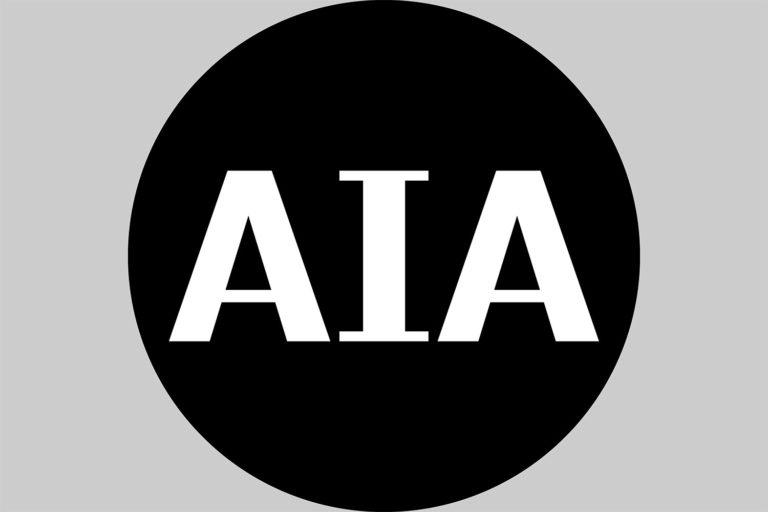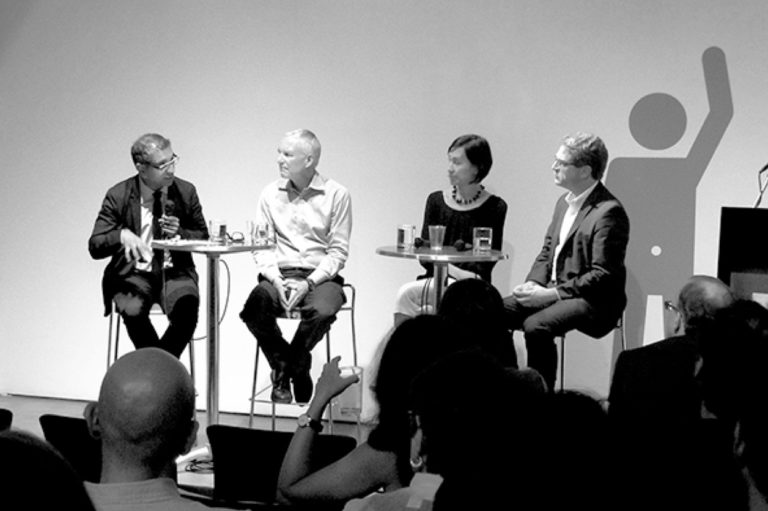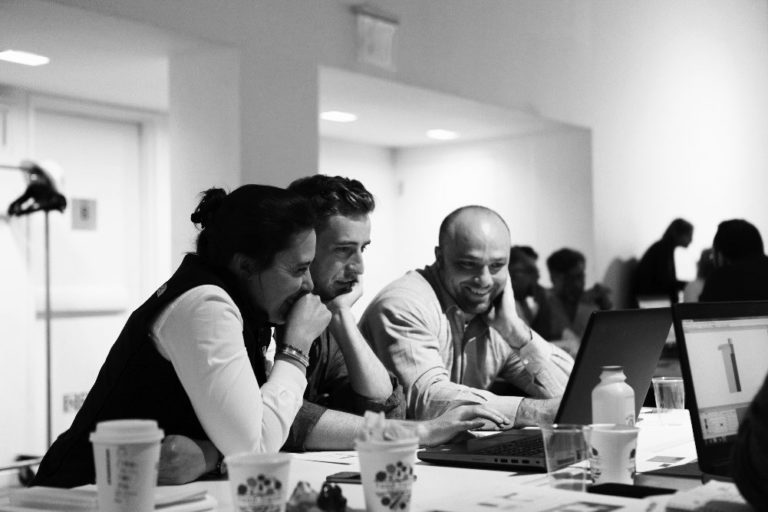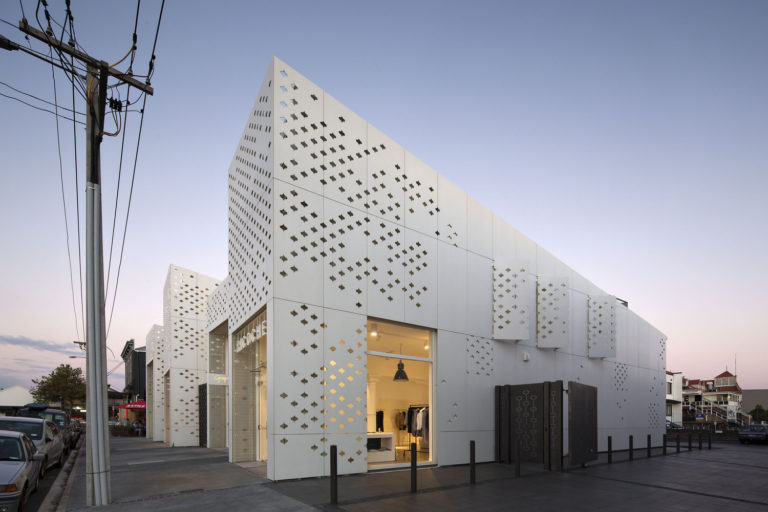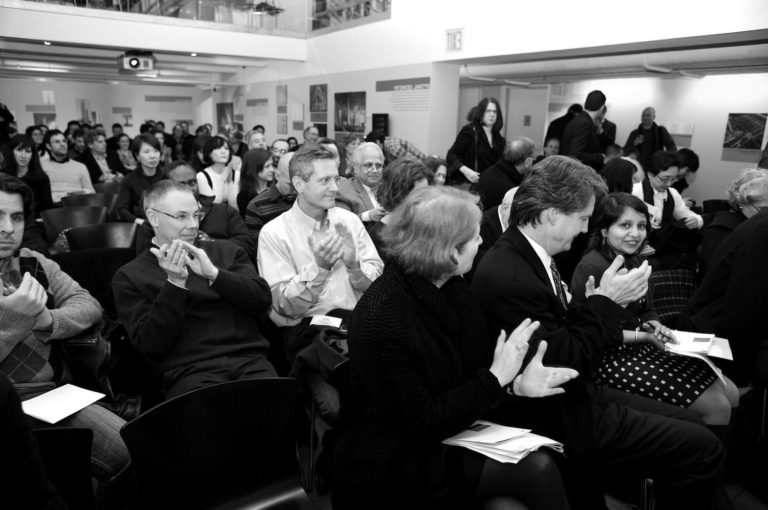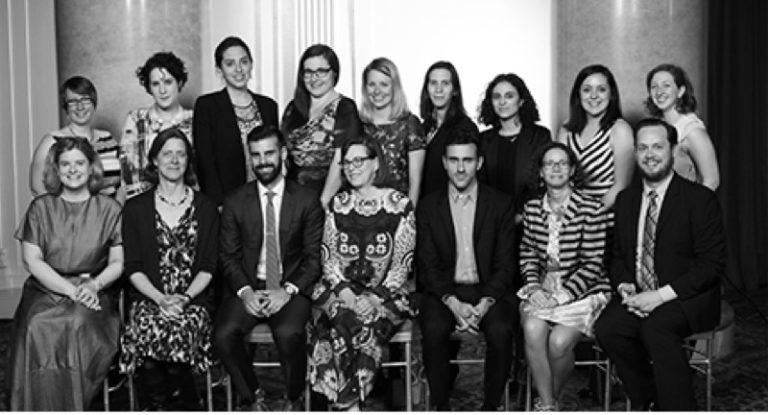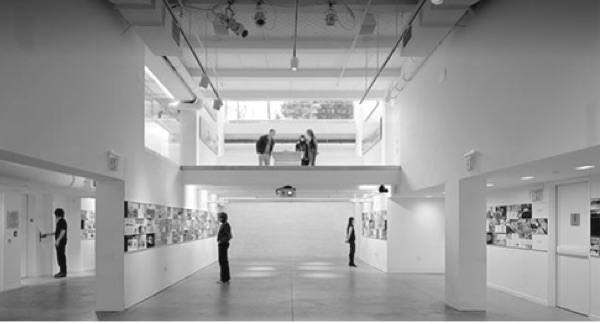by: Linda G. Miller
Boeing Opens Engineering Center for Aerospace Technology in Dayton Beach
Dedicated to the advancement of aviation, aerospace, cybersecurity, and other related fields, the new three-story, 75,000-square-foot Boeing Engineering Center in the Cici & Hyatt Brown Center for Aerospace Technology, part of the Embry-Riddle Aeronautical University’s Research Park, provides industry researchers and engineers with laboratories and collaborative working and meeting spaces. The building’s design by ikon.5 architects, is inspired by images of the cosmos. A pleated aluminum and glass façade made of an assemblage of dichroic and etched glass evokes the movement of comets, shooting stars, and nebulae. These crafted elements create a dynamic, ever-changing appearance as light shifts throughout the day, giving the building a sense of kinetic energy. The interior spaces support collaboration and creativity, anchored by the researcher’s commons, an open, welcoming space designed to foster inspiration, echoing the Center’s overarching theme of exploration and discovery. In 2020, ikon.5 architects completed the university’s Student Union Building and currently in construction is their Center for Aerospace Technology II, whose folded metal exterior is also inspired by the comets and nebulas that will be explored by the occupant researchers.
A Renovated MoMA Design Store Reopens in SoHo
After a reimagining by Peterson Rich Office (PRO), the MoMA Design Store in SoHo has reopened. Located at 81 Spring Street in a landmarked 1884 cast iron and masonry building, the two-level, 6,600-square-foot retail space has been restored to showcase the building’s historic elements, coupling them with contemporary systems for product presentation. With approval from the Landmark’s Preservation Commission (LPC), the building, which was left largely untouched since the store’s opening in 2001, underwent a renovation which included the restoration of its original columns, expansive windows, and 19th-century masonry. Windows facing Spring Street were reopened, restoring the connection between the store and the streetscape while the formerly muddy brown, now black façade underscores the dialogue between the historic fabric of the neighborhood and contemporary design within. The Spring Street entrance was also returned to its original location, restoring the building’s footprint, improving circulation, and offering a more welcoming arrival experience with a direct line of sight to the mural within. The street-facing north wall now serves as a canvas for Modern Mural, a rotating site-specific work of art that brings MoMA’s programming into the store. The first of these commissions is LOVE NYC by Nina Chanel Abney, an artist with work in MoMA’s Collection. Spanning the entire wall, the mural employs the artist’s signature paper cut-out technique depicting imagery of SoHo interspersed with references to famous works from the Museum’s collection. A newly designed front of store welcomes visitors into a rotating series of product installations, including a display dedicated to objects from MoMA’s collection that creates a shoppable link to the Museum. Custom vitrines perforated blue metal displays, and contemporary lighting now guide visitors through a fluid, experiential layout.
Faena Opens Its First New York City Hotel
Two decades after Faena debuted in Buenos Aires, and 10 years since it opened in Miami Beach, the famed hotelier brings its art-infused luxury to its just-opened New York outpost in one of the two Bjarke Ingels Group-designed sculptural towers at One High Line. Located at 500 West 18th Street in West Chelsea, the 178,900-square-foot venue occupies 10 floors of the East Tower and features 120 rooms and suites, a 5,000-square-foot concept restaurant; plus, a 15,000-square-foot subterranean spa complete with a hammam and five water features, which is expected to open in March of 2026. The interior design of spaces for rest, dining, gathering, and restoration have been conceived as an opulent, sensorial journey by the in-house Faena Design Team in collaboration with London-based Peter Mikic Studio. Situated on the second floor, the Living Room is the social heart of Faena New York and features two Deco-style bars anchoring each end, with 134 seats arranged throughout upholstered lounge areas, conversation corners, and cocktail tables. A 900-square-foot terrace opens over the High Line Park, offering seasonal outdoor seating. The Plaza, located at the front of the building is a public gathering space where Faena Art, a 501(c)(3) nonprofit arts organization, will offer interactive programming that is free and open to the public. Woods Bagot, who served as the Architect-of-Record for both towers of One High Line, continues this same role for the Faena hotel project.
Cobble Hill Condominium Takes Shape at 110 Boerum Place
Currently in construction, 110 Boerum Place, Brent Buck Architects’ first condominium project, will yield 21 luxury residences ranging from two to five bedrooms, located in the heart of the Cobble Hill section of Brooklyn. Developed by Avdoo, the project has full-block frontage on Boerum Place where the primary entry is defined by a monumental archway. The approximately 65,000-square-foot building draws inspiration from the neighborhood’s architectural landscape of low-rise brownstones and red brick buildings, stepping down from six stories on Pacific Street to four on Dean Street. The building’s red brick matches the mortar to create a unified, cohesive mass. Capitalizing on the firm’s work on townhomes, each unit has its own character and was designed as it if was an individual home. Each residence also has private landscaped outdoor space and multiple exposures. Working in collaboration with Brook Landscape, the project features a courtyard located in the rear of the first-floor lobby. The courtyard drops into the subcellar, framed by retention walls that rise to the tallest unit on the sixth floor. At the courtyard’s center, a large boulder waterfall cascades into the subgrade cellar, filling the building with a soothing soundscape. Below, the subcellar amenity spaces overlook this garden, drawing in natural light and offering views from the wellness suite, fitness suite, and playroom.
Claremont McKenna College Opens New Robert Day Sciences Center
Commissioned in 2020, the Robert Day Sciences Center is BIG’s first built project in Los Angeles, and the first completed building in the masterplan designed by the firm for Claremont McKenna College’s (CMC) Roberts Campus. With views of Mount Baldy, the 135,000-square-foot building creates a new gateway to the school and strategically facilitates connections to other academic departments. Home to advances in computational gene, brain, and climate research, the building maximizes multi-disciplinary integration and interaction as each level is oriented in a different direction, channeling the flow of people and ideas between the labs, classrooms, and the surrounding campus. The building’s structure is designed as a stack of two volumes, with each pair rotated 45 degrees from the floor below. The voids of the rotated blocks create the full-height atrium at the center of the building, which provides direct views into classrooms and research spaces from all levels. The façade incorporates board-formed panels of glass fiber reinforced concrete, which create a wood-like texture while providing the durability and fire resistance required for a modern laboratory. The roof’s 11,000 square feet of solar panels provide about 342 megawatt hours of energy production per year. A 15-foot hovering canopy welcomes students, professors, staff, and visitors, drawing them into an active, sky-lit multi-level atrium. Inside, each level bridges the level below, supported by triangular steel trusses clad in Douglas fir. The texture, rhythm, and geometry of the trusses carry through to the exterior, creating a seamless transition from inside to outside. The atrium features a large staircase meant for socializing and relaxing that connects the first two floors and a café, creating a lively hub in the center of the building. Suspended 30 feet in the air, a sculpture composed of 18 metal rings and 1,476 glass spheres by the visual artist Damien Ortega entitled Magnetic Field floats in an orbit.
New Lighting Installations in Washington Heights Celebrates Public Space
Community League of The Heights (CLOTH) and Van Alen Institute have unveiled Los Círculos, a new lighting installation designed by multidisciplinary design studio Marvel, with lighting design by Buro Happold, that puts a spotlight on two important public spaces in Washington Heights. Soft illumination from two large undulating circles transforms these spaces, creating an inviting place for interaction while increasing visibility at night. Constructed with LEDs and aluminum, the canopies have a lightweight design and minimal footprint. On view now through July 2026, Los Círculos illuminates the Plaza de las Americas, located at 175th Street and Broadway (through NYC DOT Art Partners, a collaboration with the New York City Department of Transportation’s Art Program, NYC DOT Art), and at David Friedland Square (also known as Duarte Triangle), located at 170th Street and Broadway (through the NYC Department of Parks & Recreation’s Art in the Parks Program).
In Case You Missed It…
Spacesmith has completed modernization projects at Three UN Plaza, UNICEF’s world headquarters on East 44th Street. Built in 1986 and designed by Roche-Dinkeloo, the new projects include a reinvention of the building’s public lobby and the Danny Kaye Visitor Center, spaces that present the organization’s history and humanitarian mission to the public. Labouisse Hall was upgraded and now serves as a 5,400-square-foot reception and conference center for hosting global leaders. Spacesmith serves as architect and lead design firm for the redevelopment by the United Nations Development Corporation (UNDC) of the multi-building UN Plaza complex.
Reddymade has designed Coming Together: Reimagining America’s Downtowns, an exhibition presented as part of the National Building Museum’s (NBM) Future Cities Initiative. Now open, the exhibition features examples from more than 60 large and small U.S. cities, that have undertaken innovative efforts during the last five years to breathe new life into their downtowns. The design is inspired by the pandemic-era concept of the 6-foot circle that was meant to delineate our personal space in the public sphere.
NYC Parks, the NYC Department of Design and Construction (DDC), the Department of Transportation (DOT), celebrated a major milestone of the East Side Coastal Resiliency (ESCR) Project with the reopening of the Corlears Hook Bridge, the reconstructed amphitheater, and the newly restored sports fields at East River Park. The pedestrian bridge was designed, constructed, and installed by HNTB and LiRo in collaboration with the DDC. As part of the ESCR Project, East River Park is being rebuilt at a higher elevation to provide long-term flood protection along a 2.4-mile stretch of Manhattan’s East Side.
The Annual Canstruction returns to Brookfield Place from October 30 through November 10. The event challenges teams of architects, engineers, and contractors to build sculptures made entirely out of unopened cans of food, which will be donated to City Harvest to help feed those in need.
